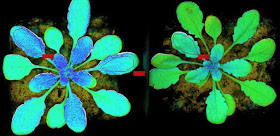Some leaves of certain species of begonias in Malaysia are luminescent blue in order to harvest maximum energy in low-light conditions.
The begonias’ chloroplasts, which use photosynthesis to convert light into fuel, have a repeating structure that allows the plants to efficiently soak up light. This is important for plants that live on the shady forest floor.
The structure acts as a “photonic crystal” that preferentially reflects blue wavelengths of light and helps the plant better absorb reds and greens for energy production, researchers report in the October 24, 2016 issue of Nature.
Colors in plants and animals typically come from pigments, chemicals that absorb certain wavelengths, or colors, of light. In rare cases, plants and animals derive their hues from microstructures. In begonias, such tiny, regular architectures can be found within certain chloroplasts, known as iridoplasts. As light bounces off these structures within an iridoplast, the reflected waves interfere at certain wavelengths creating a blue, iridescent shimmer.
These contain regularly spaced stacks of three to four 'thylakoids' - which resemble a photonic crystal and strongly reflect wavelengths of light between 430 and 560 nanometers.
The thylakoids look very similar to the artificial structures commonly used to make miniature lasers that control the flow of light. Studies of low light gathering in begonias may prove useful in improving the sharpness of color on computer and Smart phone screens.
The iridoplasts concentrate these specific wavelengths onto the plant's photosynthetic apparatus, increasing the efficiency of its photosynthesis by 5 to 10 percent.
Those structured chloroplasts also offer a survival benefit; they help the plants collect light. In a hybrid of two species, Begonia grandis and Begonia pavonina, the structures enhance the absorption of green and red wavelengths by concentrating these rays on light-absorbing compartments within the iridoplasts. Importantly, the structures slow the light. The “group velocity,” or the speed of a packet of light waves, is decreased due to interference between incoming and reflected light. The slowdown gives the plant more time to absorb precious sunbeams.
“These iridoplasts can basically photosynthesize at low-light levels where normal chloroplasts just simply could not photosynthesize,” says study coauthor Dr. Heather Whitney, a plant biologist at the University of Bristol, England. Iridoplasts, however, can’t hold their own in bright light. So begonias also have standard chloroplasts, which provide energy in plentiful sunshine. Iridoplasts act like “a backup generator” in dim conditions, Dr. Whitney says.
The Fibonacci Golden spiral on some begonia leaves is a luminescent bonus!
Blue and Fibonacci, what a duo!
Steph
The begonias’ chloroplasts, which use photosynthesis to convert light into fuel, have a repeating structure that allows the plants to efficiently soak up light. This is important for plants that live on the shady forest floor.

The structure acts as a “photonic crystal” that preferentially reflects blue wavelengths of light and helps the plant better absorb reds and greens for energy production, researchers report in the October 24, 2016 issue of Nature.
Colors in plants and animals typically come from pigments, chemicals that absorb certain wavelengths, or colors, of light. In rare cases, plants and animals derive their hues from microstructures. In begonias, such tiny, regular architectures can be found within certain chloroplasts, known as iridoplasts. As light bounces off these structures within an iridoplast, the reflected waves interfere at certain wavelengths creating a blue, iridescent shimmer.
These contain regularly spaced stacks of three to four 'thylakoids' - which resemble a photonic crystal and strongly reflect wavelengths of light between 430 and 560 nanometers.
The thylakoids look very similar to the artificial structures commonly used to make miniature lasers that control the flow of light. Studies of low light gathering in begonias may prove useful in improving the sharpness of color on computer and Smart phone screens.
The iridoplasts concentrate these specific wavelengths onto the plant's photosynthetic apparatus, increasing the efficiency of its photosynthesis by 5 to 10 percent.
Those structured chloroplasts also offer a survival benefit; they help the plants collect light. In a hybrid of two species, Begonia grandis and Begonia pavonina, the structures enhance the absorption of green and red wavelengths by concentrating these rays on light-absorbing compartments within the iridoplasts. Importantly, the structures slow the light. The “group velocity,” or the speed of a packet of light waves, is decreased due to interference between incoming and reflected light. The slowdown gives the plant more time to absorb precious sunbeams.
“These iridoplasts can basically photosynthesize at low-light levels where normal chloroplasts just simply could not photosynthesize,” says study coauthor Dr. Heather Whitney, a plant biologist at the University of Bristol, England. Iridoplasts, however, can’t hold their own in bright light. So begonias also have standard chloroplasts, which provide energy in plentiful sunshine. Iridoplasts act like “a backup generator” in dim conditions, Dr. Whitney says.
The Fibonacci Golden spiral on some begonia leaves is a luminescent bonus!

Blue and Fibonacci, what a duo!
Steph


























































